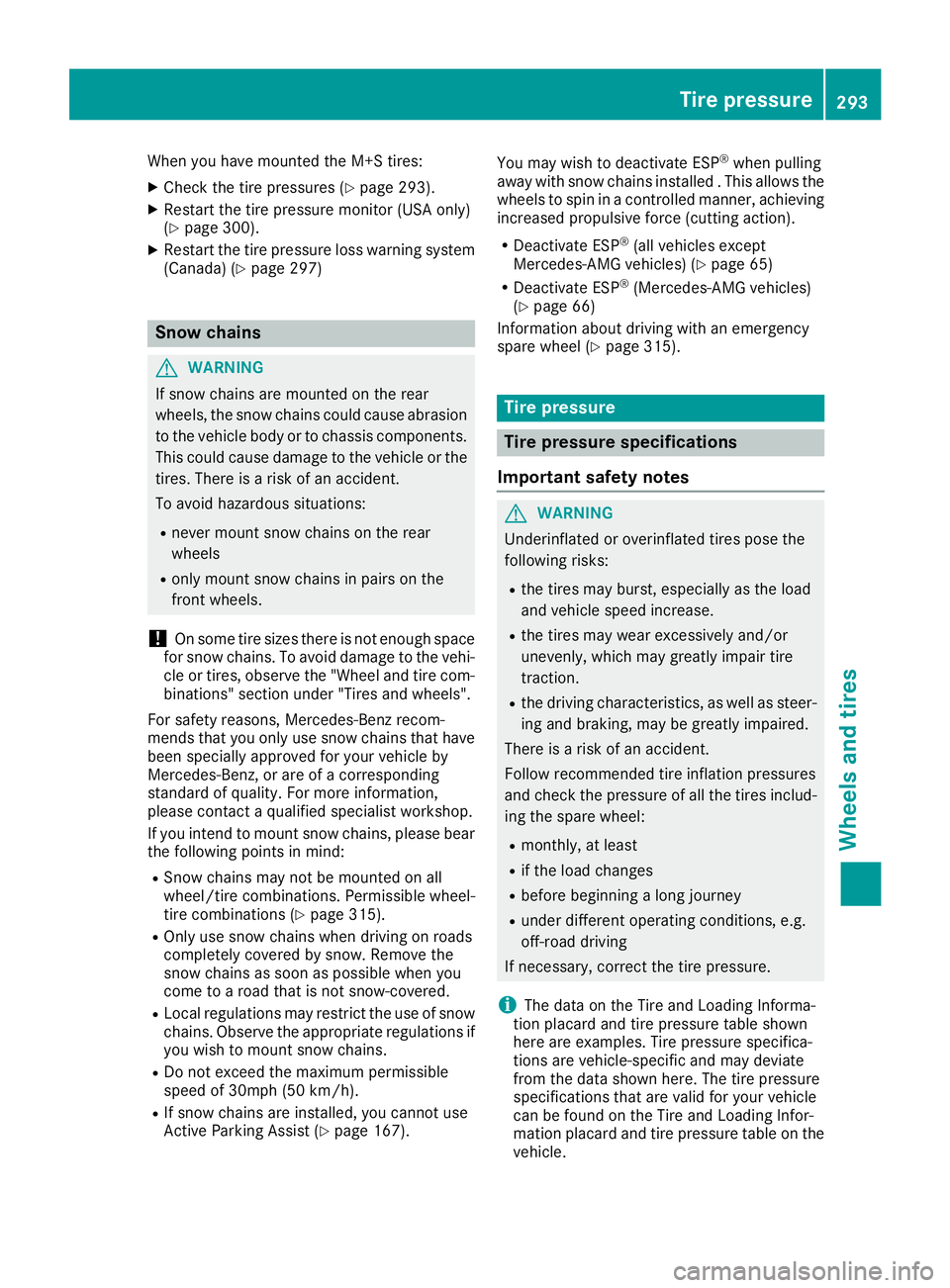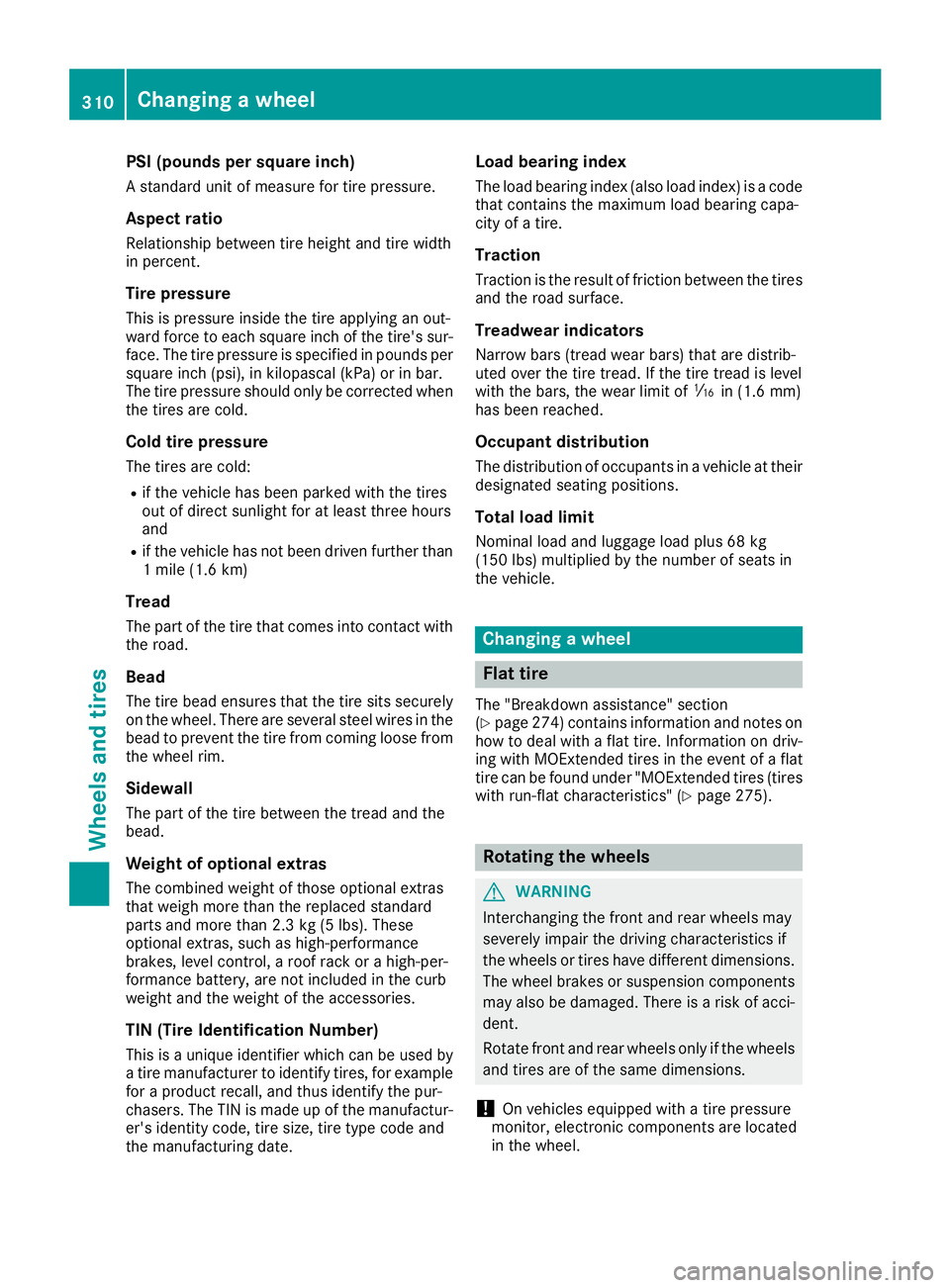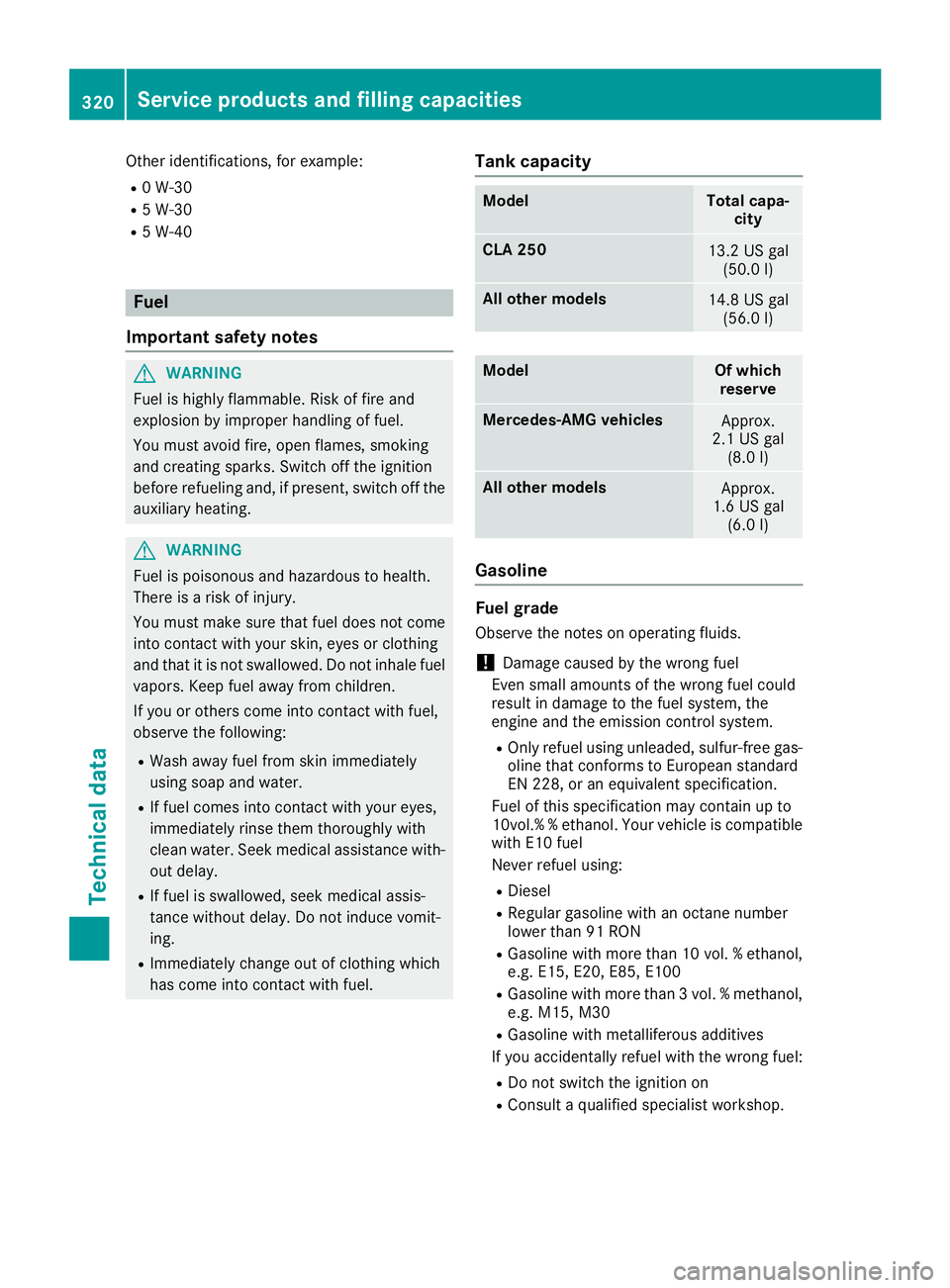Page 295 of 330

When
youhave mount edthe M+S tires:
X Check thetire pressures (Ypage 293).
X Restart thetire pressure monitor(USA only)
(Y page 300).
X Restart thetire pressure losswarning system
(Canada) (Ypage 297) Snow
chains G
WARNIN
G
If snow chains aremount edon the rear
wheels, thesnow chains couldcause abrasion
to the vehicle bodyortochassis compon ents.
This could cause damage tothe vehicle orthe
tires. There isarisk ofan accident .
To avoid hazardous situations:
R never mount snowchains onthe rear
wheels
R only mount snowchains inpairs onthe
fron twheels.
! On
some tiresizes there isnot enough space
for snow chains. Toavoid damage tothe vehi-
cle ortires, observe the"Wheel andtirecom-
bination s"sect ionunder "Tiresandwheels".
For safety reasons, Mercedes- Benzrecom-
mends thatyouonly usesnow chains thathave
been specially approved foryour vehicle by
Mercedes- Benz,or are ofacorr esponding
standard ofquality. Formore inform ation,
please contactaqualified specialist workshop.
If you inten dto mount snowchains, pleasebear
the following pointsinmind:
R Sno wchains maynotbemount edon all
wheel/tire combinations.Permissible wheel-
tire combin ations(Ypage 315).
R Only usesnow chains whendriving onroads
complet elycovered bysnow. Remove the
snow chains assoon aspossible whenyou
come toaroad thatisnot snow-c overed.
R Local regulations mayrestr ictthe use ofsnow
chains. Observe theappropriate regulationsif
you wish tomount snowchains.
R Do not exceed themaximum permissible
speed of30mph (50km/ h).
R Ifsnow chains areinstalled, youcann otuse
Act ive Parking Assist(Ypage 167). You
may wish todeactivat eES P®
when pulling
away withsnow chains installed .This allows the
wheels tospin inacont rolled manner,achieving
incr eased propulsive force(cutt ingaction ).
R Deact ivateESP®
(all vehicles except
Mercedes- AMGvehicles) (Ypage 65)
R Deact ivateESP®
(Mercedes- AMGvehicles)
(Y page 66)
Inf ormation aboutdriving withanemergen cy
spare wheel (Ypage 315). Tir
epr essure Tir
epr essure specifications
Impor tantsafety notes G
WARNIN
G
Underin flatedoroverinf latedtirespose the
following risks:
R the tires mayburst, especially asthe load
and vehicle speedincrease.
R the tires maywear exces sively and/or
unevenly, whichmaygreatly impairtire
trac tion.
R the driving charact eristics,as well assteer-
ing and braking, maybegreatly impaired.
There isarisk ofan accident .
Follow recomm endedtireinflation pressures
and check thepressure ofall the tires includ-
ing the spare wheel:
R mont hly,atleast
R ifthe load changes
R before beginnin galong journ ey
R under differen toperating conditions,e.g.
off- road driving
If neces sary,correctthe tire pressure.
i The
data onthe Tire andLoading Informa-
tion placard andtirepressure tableshown
here areexamples. Tirepressure specifica-
tions arevehicle-s pecificandmay deviate
from thedata shown here.Thetirepressure
specificat ionsthatarevalid foryour vehicle
can befound onthe Tire andLoading Infor-
mation placard andtirepressure tableonthe
vehicle. Tir
epr essure
293Wheelsandtires Z
Page 312 of 330

PSI
(pounds persquar einch)
A standard unitofmeasure fortire pressure.
Aspect ratio
Relationship betweentireheight andtirewidth
in percent .
Tire pressur e
This ispressure insidethetire apply inganout-
ward force toeach square inchofthe tire's sur-
face. Thetirepressure isspecified inpounds per
square inch(psi), inkilopascal (kPa)orinbar.
The tirepressure shouldonlybecorrect edwhen
the tires arecold.
Cold tirepressur e
The tires arecold:
R ifthe vehicle hasbeen parked withthetires
out ofdirect sunlight foratleast three hours
and
R ifthe vehicle hasnotbeen driven further than
1 mile (1.6km)
Tread
The part ofthe tire that comes intocont actwith
the road.
Bead The tirebead ensures thatthetire sits securely
on the wheel. Thereareseveral steelwires inthe
bead toprevent thetire from coming loosefrom
the wheel rim.
Sidewall The part ofthe tire between thetread andthe
bead.
Weight ofoptional extras
The combined weightofthose optional extras
that weigh morethanthereplaced standard
parts andmore than2.3kg(5lbs). These
optional extras,such ashigh-performanc e
brakes, levelcontrol,aroof rack orahigh-per-
formanc ebattery, arenot included inthe curb
weight andtheweight ofthe accessories.
TIN (Tire Identification Number)
This isaunique identifier whichcanbeused by
a tire manufacturer toidentify tires,forexample
for aproduct recall,andthus identify thepur-
chasers. TheTINismade upofthe manufactur-
er's identity code,tiresize, tiretype code and
the manufacturing date. Load
bearing index
The load bearing index(alsoloadindex) isacode
that contains themaximum loadbearing capa-
city ofatire.
Tra ction
Traction isthe result offrict ionbetween thetires
and theroad surface.
Tread wearindicators
Narrow bars(tread wearbars) thataredistrib-
uted overthetire tread. Ifthe tire tread islevel
with thebars, thewear limitof00CD in(1.6 mm)
has been reached.
Occupant distribution
The distribution ofoccupants inavehicle attheir
designated seatingpositions.
Total loadlimit
Nominal loadandluggage loadplus68kg
(15 0lbs )multiplied bythe number ofseats in
the vehicle. Changing
awheel Flat
tire
The "Breakdown assistance"section
(Y page 274)contains information andnotes on
how todeal with aflat tire. Inform ationondriv-
ing with MOExt ended tiresinthe event ofaflat
tire can befound under "MOExt endedtires(tires
with run-flat characterist ics"(Ypage 275). Rotat
ingthe wheels G
WARNING
Int erchanging thefront andrear wheels may
severely impairthedriving characterist icsif
the wheels ortires have different dimensions.
The wheel brakes orsuspension components
may alsobedamaged. Thereisarisk ofacci-
dent.
Rotate frontandrear wheels onlyifthe wheels
and tires areofthe same dimensions.
! On
vehicles equippedwith atire pressure
monitor ,electron iccomponen tsare located
in the wheel. 310
Changing
awheelWheels andtires
Page 322 of 330

Other
identifications, forexample:
R 0W-30
R 5W-30
R 5W-40 Fuel
Importa ntsafety notes G
WARNING
Fuel ishighly flammabl e.Risk offire and
explosion byimproper handlingoffuel.
You must avoid fire,open flames, smoking
and creating sparks.Switchoffthe ignition
before refueling and,ifpresent, switchoffthe
auxili aryheating. G
WARNING
Fuel ispoisonous andhazardous tohealth.
There isarisk ofinjury.
You must make surethatfueldoes notcome
into contactwith your skin, eyesorclothing
and that itis not swall owed. Donot inhale fuel
vapors. Keepfuelawayfrom children.
If you orothers comeintocontactwith fuel,
observe thefollowi ng:
R Wash awayfuel from skinimmediately
using soapandwater.
R Iffuel comes intocontactwith your eyes,
immediately rinsethem thoroughly with
clean water. Seekmedical assistance with-
out delay .
R Iffuel isswall owed, seekmedical assis-
tance without delay.Do not induce vomit-
ing.
R Immediately changeoutofclothing which
has come intocontactwith fuel. Tank
capacity Model Total
capa-
city CLA
250 13.2
USgal
(50 .0l) Al
lot her models 14.8
USgal
(56.0 l) Model Of
whic h
reserve Merce
des‑AMGvehic les Approx.
2.1 USgal
(8.0 l) All
other models Approx.
1.6 USgal
(6.0 l) Gasol
ine Fuel
grade
Observe thenotes onopera tingfluids.
! Damage
causedbythe wrong fuel
Even smallamou ntsofthe wrong fuelcould
resul tin dama getothe fuel system, the
engine andtheemiss ioncontrol system.
R Only refue lusi ng unlea ded,sulfur-free gas-
oli ne that conforms toEurope anstandard
EN 228, oran equ ivalent specifi cation.
Fuel ofthis specifi cation maycontain upto
10vol.% %ethanol .You rvehicl eis compati ble
with E10fuel
Never refuelusi ng:
R Diesel
R Reg ulargaso linewith anoctane number
low erthan 91RON
R Ga soli newith more than10vol. %etha nol,
e.g .E15, E20,E85,E100
R Ga sol ine with mor etha n3 vol .% meth anol,
e.g .M15, M30
R Ga sol ine with meta llife rou sad ditive s
If yo uacc identa lly ref uelwi th the wrong fuel:
R Do not switch theigniti onon
R Co nsu ltaqu alifi ed speci alistwo rksh op. 32
0 Se
rvi ce produc tsand fillin gca pac itiesTec hnicaldata